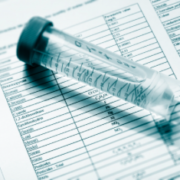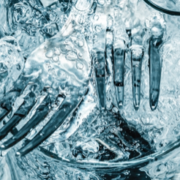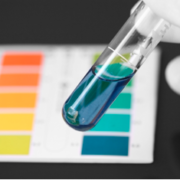What are legionella?
Legionella are bacteria that in principle always occur in water. They can also be found in streams and lakes. Usually, however, they occur in such a small number of germs that they pose no danger. They multiply well in warm water between 25 and 45 ° C. Temperatures that we often use for washing and showering. Legionella can no longer multiply below 20 ° C or above 60 ° C.
Why are Legionella dangerous?
Legionella are not transmitted from person to person. Drinking polluted water is not dangerous, nor does it come into contact with the skin. It becomes dangerous when Legionella is inhaled. A typical place of infection is therefore the shower. The pathogens are also present in the fine water vapor; when inhaled, they reach the lungs. If they get stuck there, they can cause serious diseases. Legionella are particularly dangerous for people with a weakened immune system, such as babies, children and the elderly. Legionella also pose an increased risk for chronic lung diseases or smokers.
Which diseases do Legionella cause?
Legionella are responsible for two different diseases. Anyone who comes into contact with the bacteria does not necessarily have to get sick – there are often no symptoms or those affected only perceive a mild cold. In any case, sick people are not contagious because the bacteria cannot be transmitted from person to person.
Legionnaires’ disease or Legionella pneumonia
Legionnaires’ disease is a form of pneumonia. The first symptoms appear two to ten days after coming into contact with the pathogen. Severe cough, chills, fever over 40 ° C, chest pain and headache and a feeling of severe illness are typical signs. If the disease is treated correctly, the chances of recovery are good; if treated incorrectly, it is difficult. The big challenge with Legionnaires’ disease is to make the correct diagnosis.
Because the symptoms are easily mistaken for ordinary pneumonia, Legionnaires’ disease is difficult to diagnose. Officially, the disease occurred 218 times in Austria in 2017. The AGES (Austrian Agency for Food Safety) assumes more than 1,000 cases per year in Austria. If this estimate is correct, Legionnaires’ disease will be misdiagnosed 80 percent of the time. Of the officially ill, between 4 and 14 percent die annually; there are no estimates of the number of unreported cases.
There are definitely good chances of recovery. If you experience symptoms and you suspect Legionella, inform your doctor immediately. Legionella can be detected quickly and easily and nothing stands in the way of a cure.
Pontiac fever
Pontiac fever is the more common disease caused by Legionella. It is not as severe as Legionnaires’ disease. Those affected usually complain of flu-like symptoms such as fever, general malaise, and headaches and body aches. Pneumonia does not occur, however. The incubation period is relatively short and averages one to two days.
The illness is often mistaken for summer flu because the symptoms are very similar. A high number of unreported cases is also assumed for this disease – by no means all cases are diagnosed or documented. The Pontiac fever does not have to be treated, it usually heals on its own within a week.
Deaths related to Pontiac fever are not reported.
If you suspect that you have Legionella, it is imperative that you consult a doctor. The information on our website is not intended for self-diagnosis and can in no way replace an examination by a doctor!
Where is there a risk of being infected with Legionella?
Wherever water is heated. There is therefore a risk of infection both in public facilities and in private households. Showers, public sanitary facilities, schools, hospitals, air conditioning systems and cooling towers are particularly affected. The bacteria get into the air via fine water droplets and can be easily inhaled. In principle, drinking water contaminated with Legionella is not dangerous. However, it can easily “get into the wrong tube” and the pathogens can find their way into the lungs.
Optimal conditions for the spread of Legionella can be found in showers and whirlpools. The temperature here is just right for the bacteria and they are easily inhaled via the finely atomized water vapor. Even if water stays in the pipes for a long time, a perfect breeding ground develops. For example, if you haven’t turned on the shower for two weeks because you were on vacation, you can expect a higher bacterial load in the water. The solution: Simply let the water run off for a few minutes and ventilate the room well.
But not only the location is decisive for a possible infection. People with weakened immune systems, chronic lung diseases and smokers are more at risk of becoming infected. Men are also two to three times more likely to be affected than women. But why this is not described.
How can I find out if there is Legionella in the water?
Water is the best controlled food. It has to meet strict requirements before it is given to consumers. Errors on the part of the water supplier cannot be ruled out, but in most cases contamination can be traced back to your own domestic installations. A water test can be used to find out whether legionella are dangerous in the water. That is because of how many colony-forming units can be found in it. A certain number of Legionella can be found in all bodies of water, including nature.
A legionella water test must be carried out in the laboratory. The test institute will send you a sterile container into which you can easily fill water at home. Send the sample to the laboratory by post and after a certain processing time – usually around two weeks – you will receive your result. Taking a test is a particularly good idea if there are toddlers and babies in the household. Since their immune system is not yet fully developed, the little ones are particularly susceptible to Legionella.
If problems with Legionella arise from the waterworks or the public supply network, all consumers must be informed accordingly.
How do I react correctly when Legionella is in the water?
Legionella die from a water temperature of 60 ° C. Heat therefore offers reliable protection against bacteria. In the event of an infestation, check whether the hot water in your home is set to over 60 ° C. The temperature should not drop below 55 ° C at any point in the entire pipe system.
You can also use thermal disinfection. That means nothing else than that you rinse all hot water draw-off points with at least 70 ° C hot water. Make sure that you can heat up your hot water system appropriately and allow the hot water to run off on all taps and shower heads for at least three minutes. In this way, the legionella are reliably inactivated or killed. If you have any concerns about the implementation, an installer will be happy to help.
So-called legionella circuits were common for a long time. The water was regularly heated automatically at a certain point in time. The effectiveness of this method is disputed, as it describes a habituation effect. If you regularly expose the legionella to hot water in this way, they become heat-resistant.
Thermal disinfection is the most common method, but there are other ways too. One possibility is to flush the whole system with chlorine. This process must be carried out by qualified personnel and endangers the quality of the drinking water for a certain period of time. But disinfection with chlorine is also very effective. It is also possible to disinfect with UV light. There are also separate devices that are specially designed for hot water. This method works without chemicals, but still disinfects sustainably.
In public areas – such as the showers in a dormitory – you cannot act yourself. However, operators must comply with certain hygiene regulations and take measures in the event of increased Legionella contamination.
What are the regulations regarding Legionella?
In Austria there is a “Legionella Norm” which is correctly called “ÖNORM B 5019”. This specifies regulations for the heating of drinking water in hospitals and health resorts, nursing homes, bathing establishments and accommodation establishments. When operating hot water systems for individual residential units or single-family houses, these regulations do not have to be observed. These special regulations apply to central systems because the risk is significantly higher. The standard contains numerous specifications on the materials and construction methods to be used, maintenance, operating temperature and much more. Systems that are not seen as central are not covered by the ÖNORM. This includes, for example, the water in dental treatment equipment.
Regardless of this, it is legally stipulated that drinking water must not endanger human health. Water with an increased Legionella load must therefore not be released into the distribution network.
In Germany, according to the Drinking Water Ordinance, all large systems and public buildings as well as systems for commercial purposes must regularly take water samples. In the event of a certain Legionella concentration, this must be reported to the health department and appropriate measures must be taken. There is no obligation to inspect one- and two-family houses.
In your private life, you should take good care of your water-carrying devices. Air conditioners, humidifiers, whirlpools and other equipment that work with warm water can quickly become dangerous. In any case, observe the manufacturer’s instructions regarding maintenance and care. If in doubt, do not hesitate to carry out a legionella test.
How can I prevent Legionella?
The most important and easiest way is to always heat the hot water to 60 ° C. In summer, the hot water system is often operated at lower temperatures. This may be useful for reasons of energy saving, but not a good idea with regard to Legionella. It is not for nothing that increased levels of Legionella are usually recorded in summer.
Bacteria always need a suitable breeding ground. If you have limescale issues in your home, these build up quickly. Decalcify the faucets and shower heads regularly to take away the breeding ground for bacteria. Stale water is also a good breeding ground. Here the bacteria can multiply well. Therefore, you should absolutely avoid dead strands in your pipe system and allow the water to drain off rarely used pipes regularly. Tap water after a long absence is an underestimated danger. For example, if you have been on vacation for two weeks and nobody has turned on the water in the meantime, you should flush the pipes thoroughly. The shower in particular has the potential to be dangerous. Simply turn on the water as hot as possible for a few minutes, open the window and leave the room. If you haven’t been home for just a few days, it’s a good idea to drain the water thoroughly. Stale water can also harbor other dangers – such as an increased concentration of lead.
The key is to properly maintain the entire hot water system. This includes various aspects from maintaining air conditioning systems to replacing water filters. Make sure to change the shower hose at regular intervals. Inside, a tough mixture of biofilm and limescale deposits can form, in which Legionella really feel comfortable. The installation of a decalcifying system also has a preventive effect, as this reduces the breeding ground for bacteria.






